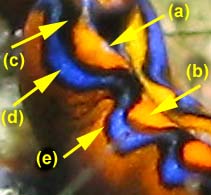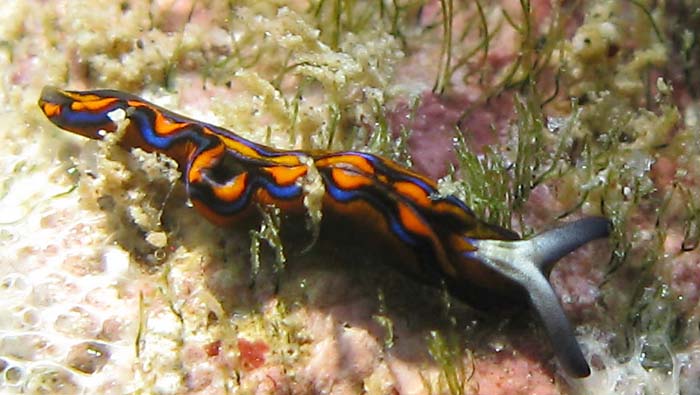This species has been observed on Reunion and Mauritius Islands
Species characteristics : The animal is orange or light to dark green with white colour markings on the head. There is a narrow white line at the parapodial margin and it is enlarged at regular intervals. Below this line are consecutive, narrow stripes of orange, black, pale blue, and black, all wavy The head and most of the rhinophores have opaque white pigment with sometimes orange marks. The tips of the rhinophores are black ( diffuse black pigment) |

|
|
| Showing species characteristics... | Photo Christophe Cadet |
|
See more about : Sightening and mating periods
See more about : Thuridilla phylogeny by Gosliner 1995
See more about : Thuridilla multimarginata variability in Southwest Indian ocean
Remarks :
Identification confirmed by Terry Gosliner and Kathe Jensen
Synonymous : (according Worms)
- No other name
Bibliographic data :
The parapodia completely cover the body and meet in a straight line along the dorsal midline
The specimen from South Africa has more diffuse black pigment on the tip of the rhinophore while the Hawaiian specimens have some green and opaque white on most of the rhinophores with black at the apex.
The anterior margin of the foot has orange, black, blue and black lines
This species is named for the multiple bands of pigmen found on and below the parapodial margins
In external morphology, T multimarginata most closely resembles to T. indopacifica and T. livida.
- All three species have orange, black and blue parapodial lines.
- But T indopacifica hasn't marginal white pigment and it has only a thin brownish black edge, then a broad band of yellow or orange, then a band of black and then a broken bright blue band.
- But T livida hasn't marginal white pigment and it has only a series of longitudinal lines of orange, black and blue.
Comparative data of the five Thuridilla with black, orange and blue margin found in our area...
T. multimarginata
Parapodial margin
Narrow white edge enlarged at regular intervals, then a narrow stripes of orange, black, pale blue, and black.
Thin brownish black edge, then a broad band of yellow-orange, and an irregular band of black. In the spaces between the blackish extensions are bright blue
Black edge followed by lines of orange, black and narrow iridescent blue
Bright yellow-orange edge, followed by a thin black line and a diffuse broad light blue to blue green band.
Broad burnt orange edge, followed by lines of black and vivid blue
Head
Opaque white pigment with sometimes orange marks
Blue with a centrally placed Y-shaped opaque white patch
Dark brown to black
Black to dark blue
Black and reflective blue pigment.
Rhinophores
They have opaque white pigment with sometimes orange marks
The tips of the rhinophores are blackThe base are whitish to pale blue. At the tips are bands of blue, black, orange-yellow and black.
Not observed in our specimensThey are dark brown to black
The apical half has opaque white pigmentThey are light blue except for the tip which is dark-blue
The base are turquoise bluish green. At the middle are narrow bands of blue and black. The apex is orange
Body
Orange or light to dark green
Translucent green with scattered opaque white spots
Dark brown to black
Black to dark blue
Turquoise bluish green
Anterior margin of the foot
It has orange, black, blue and black lines
It has black, orange-yellow , black and blue bands
It has black, orange and blue lines .
It hasn't blue and orange lines
It has orange, black and blues bands.
References :
Bill Rudman Seaslug site : Sea Slug Forum : Thuridilla multimarginata
Nudipixel Thuridilla multimarginata
Publications :
Gosliner, T.M. (1995) The genus Thuridilla (Opisthobranchia: Elysiidae) from the tropical Indo-Pacific, with a revision of the phylogeny and systematics of the Elysiidae. Proceedings of the California Academy of Sciences, 49(1) : 1-54.
Jensen, K.R. (2007). Biogeography of the Sacoglossa (Mollusca, Opisthobranchia). Bonner Zoologische Beiträge. 55: 255–281.
Other photos of Thuridilla multimarginata :
Christophe Cadet La Saline lagoon, less 1 m, 24 December 2009, size : 12 mm There narrow white line (a) at the parapodial margin is very thin in this specimen. Below this line are consecutive, narrow stripes of orange (b), black (c), pale blue (d) and black (e), all wavy  |
 |
 |
Christophe Cadet Etang salé lagoon, less 1 m, 26 May 2010, size : 12 mm A specimen with an importante white line (a) at the parapodial margin The head and most of the rhinophores have opaque white pigment with orange marks (b)
|
Christophe Cadet Etang salé lagoon, less 1 m, 30 May 2010, size : 10 mm The animal body is brown-orange to dark green-orange with white colour markings on the head.
|
 |
 |
Christophe Cadet Etang salé lagoon, less 1 m, 26 May 2010, size : 10 mm The animal body is bright-orange with white colour markings on the head. |
More photos from Indian Ocean
See more about : Thuridilla phylogeny by Gosliner 1995
See more about : Thuridilla multimarginata variability in Southwest Indian ocean
Reunion, Thuridilla multimarginata with rhinophores like a bull, at La Saline, by Christophe Cadet
Mauritius, Thuridilla multimarginata at Pointe d'Esny, by Geoffrey Summers